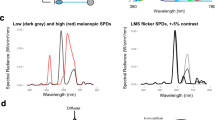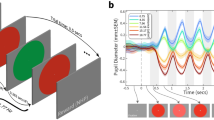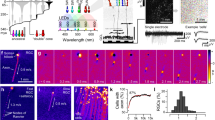Abstract
THE sensitivity of the eyes of nocturnal animals to infra-red radiations has long been a matter of much speculation. Sensitivity into the far infra-red has been claimed by Vanderplank1 for the owl—an animal with a rod retina; Matthews and Matthews2, however, working on the same animal, did not find any retinal action potentials in response to infra-red stimulation, and Hecht and Pirenne3, who were using the pupillo-motor response of the owl's eye as an index of wave-length sensitivity, found no observable contraction in response to stimulation with infra-red radiations of an energy content of 5 × 106 times that of green light, which produced a marked iris contraction.
This is a preview of subscription content, access via your institution
Access options
Subscribe to this journal
Receive 51 print issues and online access
$199.00 per year
only $3.90 per issue
Buy this article
- Purchase on Springer Link
- Instant access to full article PDF
Prices may be subject to local taxes which are calculated during checkout
Similar content being viewed by others
References
Vanderplank, F. L., Proc. Zool. Soc. Lond., 505 (1934).
Matthews, L. H., and Matthews, B. H. C., Nature, 143, 983 (1939).
Hecht, S., and Pirenne, M. H., J. Gen. Physiol., 23, 709 (1940).
Wojtusiak, R. F., Extr. Bull. Acad. Polon. Sci., B (1947).
Wojtusiak, R. F., and Mlynarski, M., Extr. Bull. Acad. Polon. Sci., B (1949).
Gunter, R., J. Physiol. (in the press).
Author information
Authors and Affiliations
Rights and permissions
About this article
Cite this article
GUNTER, R. Sensitivity of the Cat's Eye to Infra-red Radiations. Nature 167, 1062–1063 (1951). https://doi.org/10.1038/1671062a0
Issue Date:
DOI: https://doi.org/10.1038/1671062a0
Comments
By submitting a comment you agree to abide by our Terms and Community Guidelines. If you find something abusive or that does not comply with our terms or guidelines please flag it as inappropriate.



